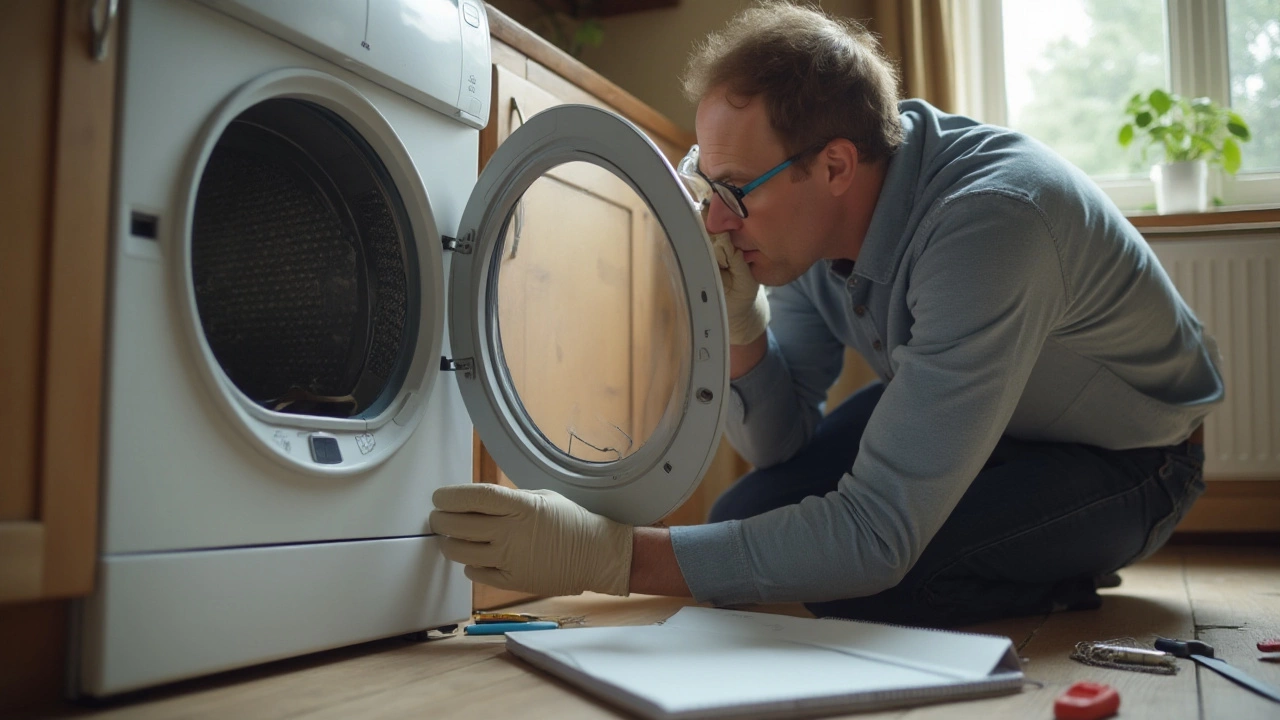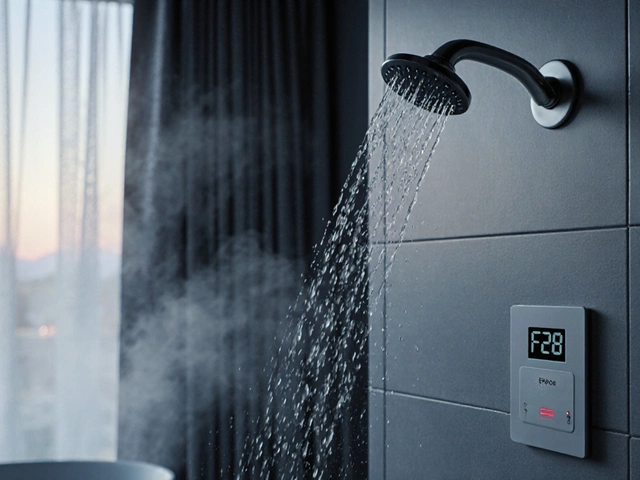Got a dryer acting up? Don’t stress. It’s a challenge that many homeowners face, but fixing it yourself could be simpler than you think. With a little patience, the right tools, and some guidance, you can tackle common dryer problems from the comfort of your own home.
Before you start, understanding a bit about how your dryer works can go a long way. Knowing the common hiccups like a pesky heating element, blocked vents, or that terrible rumbling can empower you to sort out minor issues yourself. Keep in mind, safety is key, so we’ll share some essential tips to keep you informed and safe.
If DIY isn't your cup of tea, or if you hit a roadblock, there's no shame in calling a professional. Yet, if you’re up for the adventure, let’s dig into the nuts and bolts of dryer troubleshooting! Let's ensure you’re well-equipped and confident to get that dryer working smoothly again.
- Common Dryer Problems
- Essential Tools and Safety Tips
- Step-by-Step Repair Instructions
- When to Call a Professional
- Routine Maintenance for Longevity
Common Dryer Problems
Dealing with a troublesome dryer can be quite the household hurdle. Recognizing the symptoms and understanding the common issues underlying these problems can be vital in diagnosing and fixing them yourself. The most frequent dryer repair scenario involves a machine that simply won't heat up. This could stem from a malfunctioning heating element, which essentially plays the role of a conductor, converting electrical energy into the heat required for drying your clothes. If this element breaks, the machine is rendered ineffective, leaving your laundry damp and dank.
Equally prevalent is the dryer refusing to start altogether. In this instance, the issue often lies within the door switch or thermal fuse. These small yet crucial components ensure the machine operates only when the conditions are safe—if faulty, operations will naturally screech to a halt. It’s these types of seemingly minor parts that carry significant weight in your dryer’s functional equation.
According to the Home Appliance Manufacturers Association, the average lifespan of a dryer is around 13 years, making timely repairs critical for longevity.Another pesky problem is when your dryer takes forever to finish. A likely suspect here is a clogged vent, impeding airflow. This obstructs drying efficiency, leading to extended usage and higher energy bills, not to mention potential fire hazards.
Frustrating noises are another sign that the drum or associated mechanisms might be awry. A dryer making rattling, thumping, or screeching noises can be indicative of worn drum bearings or seals, which, although not immediate detractors of functionality, can quickly escalate if left unaddressed. Ignoring such cacophony might prove costly down the line. Additionally, excessive vibrations could suggest unbalanced drum bearings or an improperly leveled unit, causing undue wear on the machine’s internal components.Tumble dryer maintenance is essential to prevent these issues from evolving into costly repairs or replacements.
If ever you notice peculiar errors in your dryer’s cycle settings or indicator lights, it might have to do with electronic control panel hiccups. These are less straightforward fixes and might necessitate professional intervention, as they involve intricate circuitry. Still, it’s empowering to know that many issues can be diagnosed with a blend of curiosity and the right DIY spirit. Before diving headfirst into repairs, however, always remember that safety should guide every decision.
Essential Tools and Safety Tips
Diving into DIY dryer repair requires a bit of preparation, and that begins with gathering the right tools for the job. Equipping yourself with a basic toolkit not only makes the task of fixing your dryer more manageable but also enhances safety, reducing risks of mishaps. A decent set of screwdrivers, both Phillips and flat-head, is indispensable. You'll also want to have needle-nose pliers on hand as well as an adjustable wrench. For those pesky, hard-to-reach screws, a multi-bit screwdriver with a long shaft can prove invaluable. If your dryer issue involves a blower wheel or belt replacement, a socket wrench set may come in handy as well.
Apart from the basics, a multimeter is a mighty ally in checking the electrical components of the dryer. This tool, when used correctly, can inform you of any electrical irregularities, which often point right to the core of the problem. Don’t forget a flashlight—often underestimated, yet crucial when peeking into the depths of your dryer. Lastly, having a digital camera or smartphone to document the disassembly process can be a lifesaver during reassembly, ensuring each wire and screw finds its rightful place.
Prioritizing Safety
While embarking on this hands-on adventure, safety should hold a paramount position in your approach. Always begin by unplugging your appliance; it’s surprising how many DIYers skip this step in their gusto. Working with any electrical device, especially one with a heating element like a dryer, demands absolute caution to prevent accidents. In the words of home repair guru Bob Vila,
"Unplugging your appliance is the simplest precaution that is most often overlooked. It's your first defense against electrical hazards."Heeding this advice isn’t just wise—it’s essential.
Wearing thick work gloves is advised to protect your hands from sharp metal edges and hot parts. If your task involves pulling your dryer apart, consider wearing knee pads for comfort during extended periods of kneeling. Additionally, keep your workspace well-lit and clutter-free; a tidy area reduces the likelihood of slipping or tripping over tools. If you're dealing with dust or lint, wearing a dust mask ensures clean breathing, particularly valuable for those with respiratory sensitivities.
Following these tips not only guarantees a safer working environment but also boosts your confidence as you tackle the intricate world of tumble dryer maintenance. With preparation and safety at the forefront, you’re set to embark on this repair journey equipped and assured.

Step-by-Step Repair Instructions
Repairing a tumble dryer doesn’t have to be daunting. With the right approach, you can handle many common issues efficiently. Let's dive into a step-by-step guide to troubleshoot and fix your dryer. First, identify what seems to be the problem. Is your dryer not heating? Or maybe it's struggling with spinning? Once you know the issue, you can target the fix more effectively, saving time and reducing frustration.
Before you start any repairs, safety should be your top priority. Ensure that the tumble dryer is turned off and unplugged. This is crucial to avoid any electrical shocks or other hazards. Gather your essential tools, which should include a multimeter, screwdrivers, and a vacuum cleaner or a brush for cleaning purposes. Having the right tools on hand will make the repair process smoother and ensure you're ready to tackle any problem you might encounter with your dryer.
Heating Issues
If your dryer isn't heating, the issue often lies with the heating element, thermostats, or thermal fuses. Begin by accessing the back panel of the dryer. Remove the screws carefully and take off the panel. Check the heating element for any visible damage or breaks. Using a multimeter, test the element for continuity. If it’s broken, it needs to be replaced.Once you’ve located the issue, the next step is to replace the damaged part. Order a compatible replacement part specific to your dryer model. Many manufacturers have detailed instructions that are easy to follow. Replacing the heating element or a fuse isn't typically complicated; however, follow every safety precaution to ensure a smooth process. Take photos of your progress as you dismantle parts so you can reference how everything fits back together.
Ventilation and Drum Issues
If your dryer is not spinning, the motor or the belt could be the culprits. A worn or broken belt is often the reason for a non-spinning drum. Open the dryer's cabinet to examine the belt. You'll want to look for obvious signs of damage like tears or excessive wear. If the belt is broken, it will need to be replaced.Dealing with motor issues could be slightly more complex, requiring you to check motor heat, brushes, and connections. If the motor appears faulty, it may be best to consult with or hire a professional. Regular maintenance of tumble dryer ventilation can prevent many issues, so regularly clean lint traps and vents to avoid overloading the machine.
Final Checks
After the repair, reassemble everything carefully. Don’t rush this step – ensure all screws are tightly fastened and each component is correctly aligned. Finally, plug in the dryer and do a test run on a short cycle to observe any unusual noises or behaviors. This can alert you to anything that might need further tweaking before use."Preventative maintenance is key to extending the life of your dryer. Regular checks and timely interventions can spare you from costly repairs." – Home Appliance Maintenance Expert
Remember, while it's satisfying and cost-effective to fix your dryer yourself, don't hesitate to seek professional help if you're unsure or the task feels overwhelming. Your safety and the performance of your dryer are worth prioritizing.
When to Call a Professional
While it’s tempting to tackle every home repair job yourself to save a few bucks, sometimes the best decision you can make is knowing when to call in a professional. With dryer repair, this judgment call hinges on the nature and complexity of the problem. A reputable repair technician provides the expertise you need, especially when your trusty dryer starts exhibiting unfamiliar or severe symptoms. While the DIY route is rewarding, getting professional help ensures you avoid making a small problem worse.
Consider calling a pro if you suspect your dryer has an electrical issue. Signs like breakers tripping frequently, sparks, or burnt smells could indicate something beyond a simple fix. Electrical troubles can pose serious safety risks if not addressed correctly. Another scenario in which to seek expert help is if your dryer isn't tumbling. Issues with the motor or the components that control its operation, such as the belt or pulley assemblies, often require delicate handling and specialized tools.
Efficiency hiccups, such as your clothes taking ages to dry, might seem straightforward to handle, but the cause could be more complex than a clogged vent. If cleaning the lint trap doesn’t help, a technician might uncover deeper issues like ventilation blockages or failing thermostats. A persistent problem should serve as a red flag that professional intervention is necessary. In these situations, contingent repairs may only provide a temporary fix.
Another clear indication to seek expert assistance is the appearance of unusual noises. Although some noises might indicate minor issues, others can hint at significant mechanical failures. For instance, a screeching sound could come from worn drum bearings, while thumping or grinding noises might arise from more severe concerns within the bearings or glides. These assessments often require disassembly of key parts and a practiced hand to identify the root cause accurately.
Finally, remember that modern dryers come with complex parts and smart features, and manufacturers often require professional service for warranty claims. Attempting a repair yourself could inadvertently void your warranty or worsen problems due to unfamiliarity with newer technology. As one seasoned repair expert notes,
"Sometimes spending a little on a professional can save large costs down the line."
In essence, knowing when to call a professional is part of being a savvy homeowner. When in doubt, prioritize safety and efficacy over cost-saving measures. Understanding the limitations of DIY can save your money and your nerves in the long haul.

Routine Maintenance for Longevity
Maintaining your dryer might not be top of mind until problems arise, but routine upkeep is crucial to extend its life. Think of it as giving your trusty companion a regular check-up, ensuring it stays in peak condition for years to come. Keeping your dryer in great shape isn’t just about preventing breakdowns; it’s about efficiency too. When a dryer struggles with its workload, it consumes more energy and increases utility bills, which is an unnecessary expense for any household. Start by lint screen cleaning, a task often overlooked. The accumulation of lint can lead to decreased air circulation; scale it back by removing lint after each load. A clean lint trap isn’t just for efficiency, it’s also key to avoiding dryer fires, a serious risk reported by safety authorities worldwide.
"More than 15,000 fires associated with clothes dryers occur annually, often due to lint build-up," warns a report from the National Fire Protection Association.
Beyond the lint trap, consider the vent system and drum care. Regularly checking for blockages within the exhaust vent is a simple yet effective way to uphold performance. Every few months, disconnect the exhaust duct and give it a thorough clean-out. If you notice heavier clothing requiring extended drying times, this might be due to vent obstructions affecting airflow. Similarly, inspecting the drum seals and the interior for signs of wear can prevent the drum from becoming off-kilter – an issue that causes loud clattering during operation. Additionally, applying a bit of spray lubricant to the drum's motor bearings can reduce friction. This is like the quiet magic touch aimed at keeping your washer running smoothly.
How do you know when a drum seal isn’t quite right? It's not always obvious, but unusual noises or visible gaps around the drum are tell-tale signs. To pinpoint issues early, perform routine checks every few months. It’s a bit like a health check-up; minor adjustments can help avert major, costly damages down the line. Regular usage of your dryer necessitates occasional tightening of loose screws and adjustments of the leveling legs. You don’t want it to wobble precariously, so ensure it sits level. Stability prevents operational issues and keeps your appliance running efficiently. Lastly, don't forget to perform a diagnostic test. Many modern dryers come equipped with these handy features, allowing you to detect irregularities your eyes and ears might miss. Running a diagnostic every six months or so helps spot concerns before they morph into major problems.




